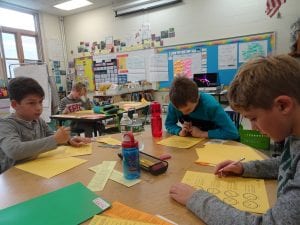 We’ve spent our week focused on portfolio preparations, beginning an inquiry into national holidays, learning more about elapsed time and stopping for a moment to count our blessings. We’ve learned a bit about the history of Thanksgiving and how it came to be celebrated. It’s kind of cool to know that New Hampshire’s own, Sarah Josepha Hale was instrumental in creating American’s special holiday. I am hopeful that by the time you read this note, each child will have completed his or her blog sharing a thankfulor gratefulacrostic. Their thoughts are beautiful. Enjoy them.
We’ve spent our week focused on portfolio preparations, beginning an inquiry into national holidays, learning more about elapsed time and stopping for a moment to count our blessings. We’ve learned a bit about the history of Thanksgiving and how it came to be celebrated. It’s kind of cool to know that New Hampshire’s own, Sarah Josepha Hale was instrumental in creating American’s special holiday. I am hopeful that by the time you read this note, each child will have completed his or her blog sharing a thankfulor gratefulacrostic. Their thoughts are beautiful. Enjoy them.
Student Goal Setting and Portfolio Shares
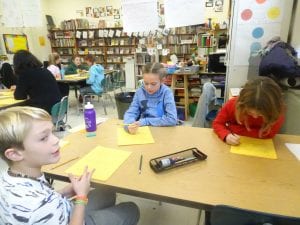 Thank you for spending time with your son or daughter as they shared what they are learning, their classroom and their goals for this year. They are growing their abilities to reflect on their learning processes. Since we began this process, they can already see they have changed. They realized how they grown as a mathematician by seeing problems from early October. It is motivating to find proof of learning and to feel the rewards of focus and effort. The more actively the children participate in their own learning, the more they will grow.
Thank you for spending time with your son or daughter as they shared what they are learning, their classroom and their goals for this year. They are growing their abilities to reflect on their learning processes. Since we began this process, they can already see they have changed. They realized how they grown as a mathematician by seeing problems from early October. It is motivating to find proof of learning and to feel the rewards of focus and effort. The more actively the children participate in their own learning, the more they will grow.
 It is exciting to see their thoughtfulness and their enthusiasm for sharing what they do each day. They deserve to be proud of their efforts and abilities to present their thinking and learning at this point in the year. I appreciate knowing what they are thinking. They always surprise me. Their ideas and approach to each task is totally unique. They teach me something new every day.
It is exciting to see their thoughtfulness and their enthusiasm for sharing what they do each day. They deserve to be proud of their efforts and abilities to present their thinking and learning at this point in the year. I appreciate knowing what they are thinking. They always surprise me. Their ideas and approach to each task is totally unique. They teach me something new every day.
Book Clubs – Keeping Track Thinking While Reading
 Last week the children participated in book clubs. Our first book club choices were centered on the idea that everyone can write what they know and feel in their hearts. All of these first choices were picture books and the clubs were designed so that everyone could meet the expectations of 1) completing the book, 2) writing a summary, 3) selecting a favorite part to speak to and 4) to make an inference about the author’s message. All of the children met these expectations and had some great discussions about their books and reading.
Last week the children participated in book clubs. Our first book club choices were centered on the idea that everyone can write what they know and feel in their hearts. All of these first choices were picture books and the clubs were designed so that everyone could meet the expectations of 1) completing the book, 2) writing a summary, 3) selecting a favorite part to speak to and 4) to make an inference about the author’s message. All of the children met these expectations and had some great discussions about their books and reading.
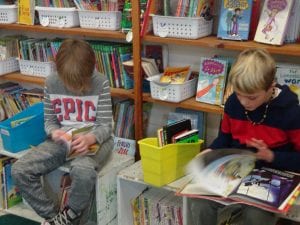 Our second book clubs selections all have something to do with Thanksgiving. They are nonfiction selections and have a wide range of length and complexity. We’ll be learning more about note-taking and questioning during these book club meetings. We’ll use what we learn during these meetings to guide us into our second inquiry project about national holidays.
Our second book clubs selections all have something to do with Thanksgiving. They are nonfiction selections and have a wide range of length and complexity. We’ll be learning more about note-taking and questioning during these book club meetings. We’ll use what we learn during these meetings to guide us into our second inquiry project about national holidays.
Bits and Pieces –
- We finished The Wild Roboton Wednesday. There was a resounding “YES” when I asked if we wanted to read The Wild Robot Escapes next. Roz is an amazing robot. We loved the book so much we’ve decided to build some robots of our own. It will be fun to see the personalities of our robots emerge.
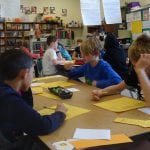
- Just a reminder – we’ve got a field trip on Monday to Strawbery Banke. We’ll be there for the morning and will be returning to school around 1:00. The children will need to bring their lunch – or order lunch from school as yesterday’s notice outlined. We’ll be eating lunch on the bus while we return from the program. Please be aware of the peanut and tree nut allergies in the grade. Thank you.
- We’ve continued to learn more about simple and compound sentences. We are learning more about the choices we make can add to interest to our writing.
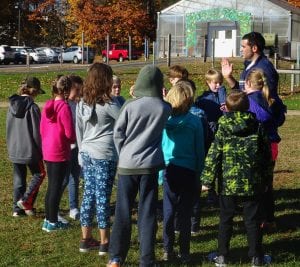 Happy Veterans Day! We’re getting ready to develop our weather forecasts as we end of our weather unit of study. This week we’ve begun exploring our nation’s history by learning some about our nine national holidays. We’ve continued to discuss and plan for how we can each contribute to the creation of a successful learning community. We’ve been learning about sentences and parts of speech – nouns, verbs and adjectives. And finally, we’ve been exploring time. We’re learning about elapsed time and how to use what we know about fives and multiplication to connect with telling time. We’re always trying to get the most out of our time.
Happy Veterans Day! We’re getting ready to develop our weather forecasts as we end of our weather unit of study. This week we’ve begun exploring our nation’s history by learning some about our nine national holidays. We’ve continued to discuss and plan for how we can each contribute to the creation of a successful learning community. We’ve been learning about sentences and parts of speech – nouns, verbs and adjectives. And finally, we’ve been exploring time. We’re learning about elapsed time and how to use what we know about fives and multiplication to connect with telling time. We’re always trying to get the most out of our time. We’ve been struggling with behavior for the past two weeks. Both of these weeks have been full of unusual schedules and events. Because of this, I waited to see if we could pull it together. Some have, but others have not. As a class, we mean well, but behavior choices have left much to be desired. This, along with little attention to personal best and/or thoughtful effort, is prompting me to ask you to have a chat with your child about what they might do to support their own learning. We’ve been reading about teamwork and cooperation. We’ve had lots of examples and now we need to make some important choices. If you have a chance, talk to your child about what s/he could do put forth best effort? Ask how can s/he contribute to creating a classroom community allowing everyone to succeed? These conversations will help us continue them in our classroom, so we can be sure that learning is what we are about at school.
We’ve been struggling with behavior for the past two weeks. Both of these weeks have been full of unusual schedules and events. Because of this, I waited to see if we could pull it together. Some have, but others have not. As a class, we mean well, but behavior choices have left much to be desired. This, along with little attention to personal best and/or thoughtful effort, is prompting me to ask you to have a chat with your child about what they might do to support their own learning. We’ve been reading about teamwork and cooperation. We’ve had lots of examples and now we need to make some important choices. If you have a chance, talk to your child about what s/he could do put forth best effort? Ask how can s/he contribute to creating a classroom community allowing everyone to succeed? These conversations will help us continue them in our classroom, so we can be sure that learning is what we are about at school.

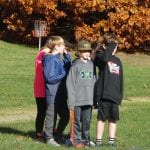
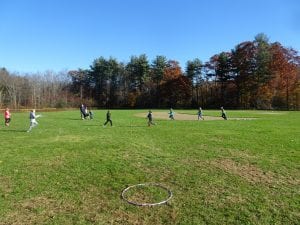 Our outdoor challenge this week was about teamwork too. The class was divided into groups and sent to three different stations. We were told we had to listen carefully to all the directions, take turns and allow everyone to participate. Our goal was to move all the objects from one hoop into another hoop. With those directions, the class began. Ask your child what he or she discovered working through this challenge. Perhaps Open Circle and the challenge can help your child in coming up with ideas of how our classroom can be a place where everyone can succeed in the manner that makes him or her proud.
Our outdoor challenge this week was about teamwork too. The class was divided into groups and sent to three different stations. We were told we had to listen carefully to all the directions, take turns and allow everyone to participate. Our goal was to move all the objects from one hoop into another hoop. With those directions, the class began. Ask your child what he or she discovered working through this challenge. Perhaps Open Circle and the challenge can help your child in coming up with ideas of how our classroom can be a place where everyone can succeed in the manner that makes him or her proud.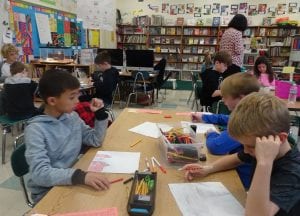 We’ve been exploring different types of sentences. We’ve learned about simple, and compound sentences. We know each sentence has a noun that is its subject. We know that the subject of the sentence has to do something, and then we are hoping to elaborate on the basic sentence structure by adding adjectives to paint a picture of our meaning with our word choice.
We’ve been exploring different types of sentences. We’ve learned about simple, and compound sentences. We know each sentence has a noun that is its subject. We know that the subject of the sentence has to do something, and then we are hoping to elaborate on the basic sentence structure by adding adjectives to paint a picture of our meaning with our word choice. We’re nearing the end of
We’re nearing the end of 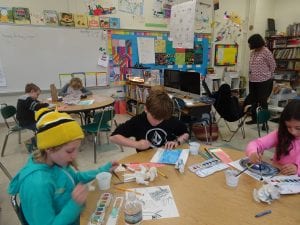

 Student-Led Goal setting conferences will be on Thursday, November 15 or Friday, November 16.
Student-Led Goal setting conferences will be on Thursday, November 15 or Friday, November 16.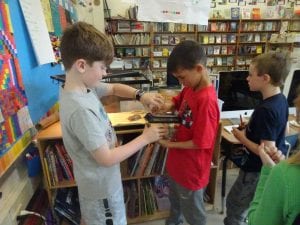 What an exciting week – Trick-or-Treating, Halloween and welcoming our new classroom pet. Finally the Reptile Keeper has a real job to do everyday. On top of all that, our week has also been filled with reading, writing, researching, science and problem solving. Your children are hardworking, flexible and interested in learning. It seems as though 3E is a good place to be learning.
What an exciting week – Trick-or-Treating, Halloween and welcoming our new classroom pet. Finally the Reptile Keeper has a real job to do everyday. On top of all that, our week has also been filled with reading, writing, researching, science and problem solving. Your children are hardworking, flexible and interested in learning. It seems as though 3E is a good place to be learning. This week we continued our goal setting process. As I’ve already shared, the students have described themselves as learners using the Multiple Intelligences model, they’ve described themselves as readers and writers, chosen “best” books and pieces of writing to highlight what they are capable of doing independently at this point in the school-year and set reading and writing goals. These goals come from the traits of successful readers and writers we generated as a class. Each of the children has chosen something they feel they would like to pay attention to and improve. Our last goal-setting area is math. We will have they completed by the middle of next week. We’ll spend a few days organizing our portfolios and planning how we will share all our ideas with our families. In the second week of November we will be organized and ready to share.
This week we continued our goal setting process. As I’ve already shared, the students have described themselves as learners using the Multiple Intelligences model, they’ve described themselves as readers and writers, chosen “best” books and pieces of writing to highlight what they are capable of doing independently at this point in the school-year and set reading and writing goals. These goals come from the traits of successful readers and writers we generated as a class. Each of the children has chosen something they feel they would like to pay attention to and improve. Our last goal-setting area is math. We will have they completed by the middle of next week. We’ll spend a few days organizing our portfolios and planning how we will share all our ideas with our families. In the second week of November we will be organized and ready to share.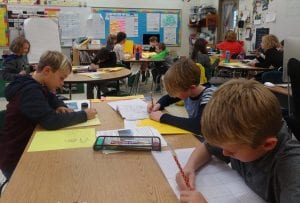 The students will lead their conference and share their learning profiles, work samples and goals with you. The main goal of this reflection and writing SEL project is to help the children come to understand themselves as learners a bit better. It is designed to help each of them realize they are unique and totally capable of accomplishing whatever they are willing to work for.
The students will lead their conference and share their learning profiles, work samples and goals with you. The main goal of this reflection and writing SEL project is to help the children come to understand themselves as learners a bit better. It is designed to help each of them realize they are unique and totally capable of accomplishing whatever they are willing to work for.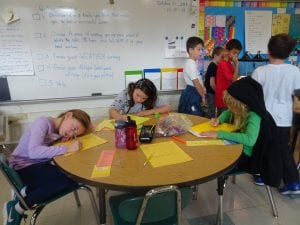 We’ve continued to learn more about adjectives and descriptive writing. We’ve practiced writing descriptive sentences about weather. We’ve had the chance to create adjective poems. We made one together about our gecko and the children wrote their own about the leaves they created in our symmetry project.
We’ve continued to learn more about adjectives and descriptive writing. We’ve practiced writing descriptive sentences about weather. We’ve had the chance to create adjective poems. We made one together about our gecko and the children wrote their own about the leaves they created in our symmetry project. : to write what they understand, to write to teach others, to write in their own words, to write between 25 and 30 sentences (at least five sentences about five sub-topics) – more is always better, and to create their own illustrations to share their understanding of the topic. They are excited to be sharing their weather library with others.
: to write what they understand, to write to teach others, to write in their own words, to write between 25 and 30 sentences (at least five sentences about five sub-topics) – more is always better, and to create their own illustrations to share their understanding of the topic. They are excited to be sharing their weather library with others.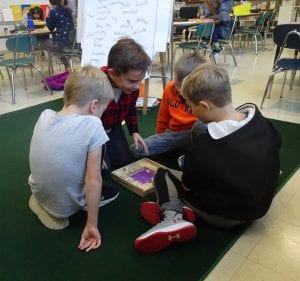 We’ve continued to explore
We’ve continued to explore 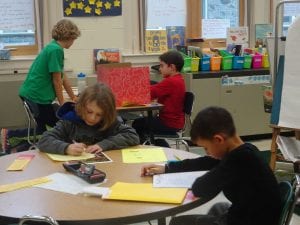 Our
Our 
 We are very busy. We’re trying to establish a safe habit for our class reptile – leopard geckos. They live in the desert so it has to be hot. We are trying to find a safe way to make sure the temperature doesn’t drop too much at night and on the weekends. It’s been an interesting and exciting process. We also had the opportunity (a high pressure system moving in) to set up our storm glass so now our weather corner has another tool that we can use to predict the weather.
We are very busy. We’re trying to establish a safe habit for our class reptile – leopard geckos. They live in the desert so it has to be hot. We are trying to find a safe way to make sure the temperature doesn’t drop too much at night and on the weekends. It’s been an interesting and exciting process. We also had the opportunity (a high pressure system moving in) to set up our storm glass so now our weather corner has another tool that we can use to predict the weather.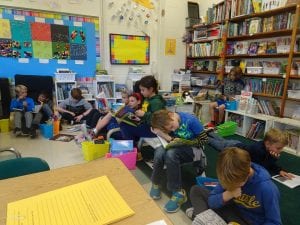 This week we’ve spent time thinking about goals. We’ve tried to be specific. We’ve tried to make our goals about something important and doable. We’re also thinking about the evidence we might collect to show we have accomplished our goals.
This week we’ve spent time thinking about goals. We’ve tried to be specific. We’ve tried to make our goals about something important and doable. We’re also thinking about the evidence we might collect to show we have accomplished our goals. Once we discovered what we might do to grow as readers, we set a goal for the week. We called it a W.O.W. (within one week) goal. We’ve discovered that even though we know how we might improve our reading skills, we don’t always do what will help us. We really do have to make a plan if we are going to accomplish what we set out to do. We’re trying to explore new books and spend more time thinking about what we’re reading. They deserve to be proud of all they are attempting and doing as readers.
Once we discovered what we might do to grow as readers, we set a goal for the week. We called it a W.O.W. (within one week) goal. We’ve discovered that even though we know how we might improve our reading skills, we don’t always do what will help us. We really do have to make a plan if we are going to accomplish what we set out to do. We’re trying to explore new books and spend more time thinking about what we’re reading. They deserve to be proud of all they are attempting and doing as readers.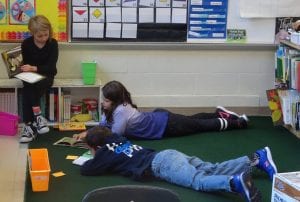 This month our calendar is filled with a pattern of polygons. We’re learning about different types of triangles, quadrilaterals, pentagons and hexagons. We’ve discovered that when they are called “regular” shapes the sides and angles are equal. “Regular” shapes often have many lines of symmetry. Symmetry is all around us. We’ve looked for things in the classroom that are symmetrical and we’ve explored symmetry in nature too.
This month our calendar is filled with a pattern of polygons. We’re learning about different types of triangles, quadrilaterals, pentagons and hexagons. We’ve discovered that when they are called “regular” shapes the sides and angles are equal. “Regular” shapes often have many lines of symmetry. Symmetry is all around us. We’ve looked for things in the classroom that are symmetrical and we’ve explored symmetry in nature too.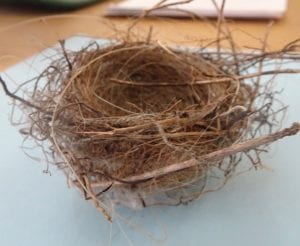 Survival
Survival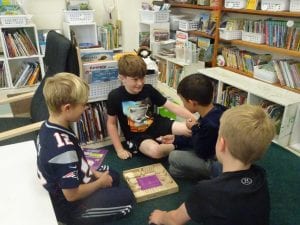 The Wild Robot
The Wild Robot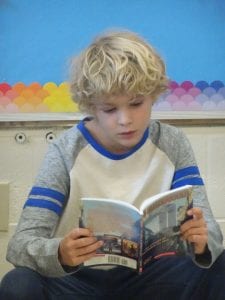 3rd Grade Challenges – 3E
3rd Grade Challenges – 3E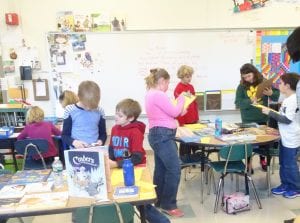 Thanks for supporting our reading museum and helping the children take note of he fact that learning continues on and on. Thank you also for your attention to making time for homework. Many of the kids were super excited about having that responsibility. We began our week by thinking about a series of precepts: “If at first you don’t succeed, try, try again.”, “Practice makes perfect.”, “”Whether you think you can or whether you think you can’t, you’re probably right.”, and ”Practice makes progress.” We had some great conversation about what we can do to make sure learning grows.
Thanks for supporting our reading museum and helping the children take note of he fact that learning continues on and on. Thank you also for your attention to making time for homework. Many of the kids were super excited about having that responsibility. We began our week by thinking about a series of precepts: “If at first you don’t succeed, try, try again.”, “Practice makes perfect.”, “”Whether you think you can or whether you think you can’t, you’re probably right.”, and ”Practice makes progress.” We had some great conversation about what we can do to make sure learning grows.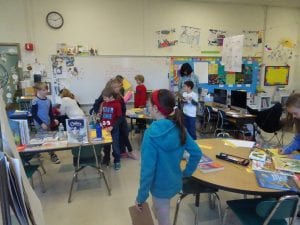
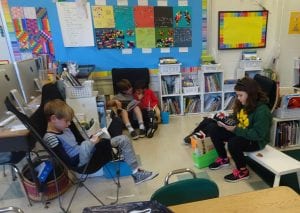 After the museum on Tuesday, we reflected on the reading we’d been doing in the first month and a half of school. We thought about the books we’d been choosing to read and we considered the difference between “reading”, “skimming and scanning” and “looking through.” All are important habits to have, but we agreed that much of the time we have in our classroom with books should be dedicated to reading. The only way to grow as a reader is to practice. We reflected on what we’d been reading so far and the school year, and what habits we’d been most focused on. Are next steps will be to develop goals that will lead us forward and help us to grow.
After the museum on Tuesday, we reflected on the reading we’d been doing in the first month and a half of school. We thought about the books we’d been choosing to read and we considered the difference between “reading”, “skimming and scanning” and “looking through.” All are important habits to have, but we agreed that much of the time we have in our classroom with books should be dedicated to reading. The only way to grow as a reader is to practice. We reflected on what we’d been reading so far and the school year, and what habits we’d been most focused on. Are next steps will be to develop goals that will lead us forward and help us to grow. We’ve been learning how to use what we know about place value to help us multiply larger amounts. We’ve been trying to use the distributive property, because these steps more often help us with accuracy. They remind use to multiply everything – not just the hundreds and tens, but also the ones.
We’ve been learning how to use what we know about place value to help us multiply larger amounts. We’ve been trying to use the distributive property, because these steps more often help us with accuracy. They remind use to multiply everything – not just the hundreds and tens, but also the ones. We learned about four different types of leads: snapshot, question, dialogue and onomatopoeia. We had a go at playing around with each of them. We’ve tried choosing words that paint a picture. We’ve thought about the sounds we’d hear if we were to enter the setting of our piece of writing to consider if that would make an impactful start. We’ve thought of creating characters to speak and introduce our topic or story. And finally, we’ve wonder about the questions we hope our writing will answer. See if your child can tell you about the lead he or she is most interested in using to introduce readers to weather.
We learned about four different types of leads: snapshot, question, dialogue and onomatopoeia. We had a go at playing around with each of them. We’ve tried choosing words that paint a picture. We’ve thought about the sounds we’d hear if we were to enter the setting of our piece of writing to consider if that would make an impactful start. We’ve thought of creating characters to speak and introduce our topic or story. And finally, we’ve wonder about the questions we hope our writing will answer. See if your child can tell you about the lead he or she is most interested in using to introduce readers to weather. We’ve posted
We’ve posted 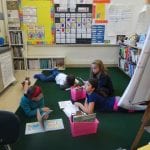

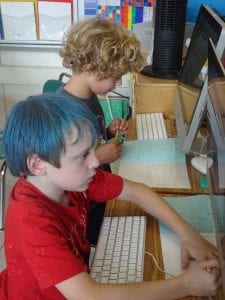
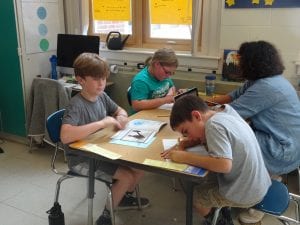
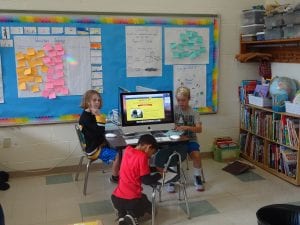 For a short week, we certainly fit a lot in. We continued our weather research. We’re finding out a lot of interesting facts. We began student blogging this week. The class is very excited about creating a first post. Thanks to those families who were able to read them and leave a comment. Please share the blog url with family and friends, near and far. It is exciting to open the blogs and find comments from grandparents, aunts and uncles. Thank you for your time and attention with this.
For a short week, we certainly fit a lot in. We continued our weather research. We’re finding out a lot of interesting facts. We began student blogging this week. The class is very excited about creating a first post. Thanks to those families who were able to read them and leave a comment. Please share the blog url with family and friends, near and far. It is exciting to open the blogs and find comments from grandparents, aunts and uncles. Thank you for your time and attention with this.

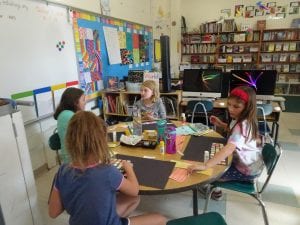 We’ve been learning how to create and read arrays. This practice enabled all of us to understand how the Commutative Property of Multiplication works. It doesn’t matter if you have 3 rows of 4 or 4 rows of 3. Both equal twelve. To show this understanding we made buildings to create Multiplication Main Street. Our buildings show how this property works.
We’ve been learning how to create and read arrays. This practice enabled all of us to understand how the Commutative Property of Multiplication works. It doesn’t matter if you have 3 rows of 4 or 4 rows of 3. Both equal twelve. To show this understanding we made buildings to create Multiplication Main Street. Our buildings show how this property works.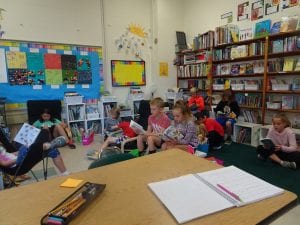
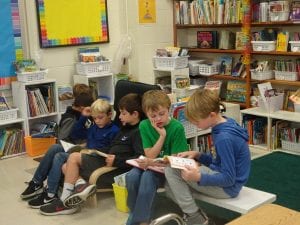
 We’ve begun our
We’ve begun our 
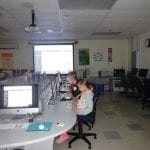 We have continued to work on our
We have continued to work on our 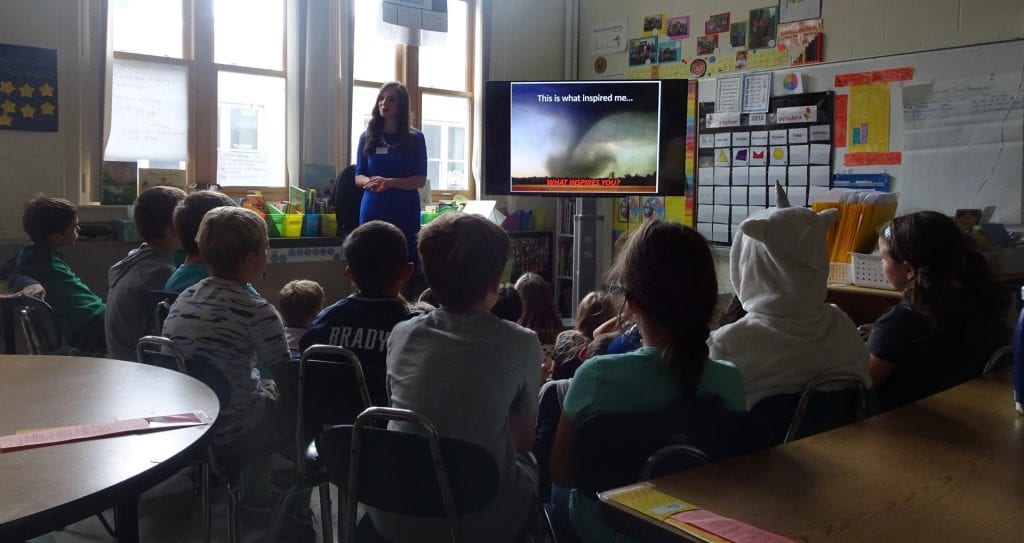 Our week seems to fly by. I guess that’s a good thing – we are exploring lots of things every day and all seem to be enjoying what we are doing. This week we finished our third chapter read-aloud for the year. With the help of Mrs. Wyman, the students were each able to take the first step in setting up their personal learning blog. We’ve begun our first research project and feel surer about how the commutative property of multiplication works.
Our week seems to fly by. I guess that’s a good thing – we are exploring lots of things every day and all seem to be enjoying what we are doing. This week we finished our third chapter read-aloud for the year. With the help of Mrs. Wyman, the students were each able to take the first step in setting up their personal learning blog. We’ve begun our first research project and feel surer about how the commutative property of multiplication works. During our Open Circle discussions during the last few weeks we’ve been discussing feeling and emotions. We’ve sorted them, calling some uncomfortable and other comfortable. We’ve wondered if we always know how we are feeling – we’ve discussed how breathing can help us relax. We’ve also discovered that we can read other people’s emotions by paying attention to their body language.
During our Open Circle discussions during the last few weeks we’ve been discussing feeling and emotions. We’ve sorted them, calling some uncomfortable and other comfortable. We’ve wondered if we always know how we are feeling – we’ve discussed how breathing can help us relax. We’ve also discovered that we can read other people’s emotions by paying attention to their body language.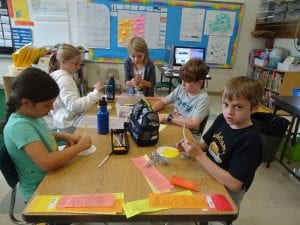 Our goal in daily problem solving is to offer the children opportunities to practice logical thinking and to find ways to use new knowledge to become more efficient over time. The children choose a strategy they can use to document their thinking and follow through to an accurate solution. This is challenging. When you and I read the problems we see that most of them can be solved with multiplication, but because it is still new to your children, it is not always their choice.
Our goal in daily problem solving is to offer the children opportunities to practice logical thinking and to find ways to use new knowledge to become more efficient over time. The children choose a strategy they can use to document their thinking and follow through to an accurate solution. This is challenging. When you and I read the problems we see that most of them can be solved with multiplication, but because it is still new to your children, it is not always their choice. At this point you’ll notice any range of strategies. Sometime the children are drawing out the problems. This can become cumbersome and mistakes are often made when counting. Sometimes children are skip counting or using a doubling strategy. Sometimes children are able to mentally manipulate amounts in their minds but are off by a bit when the value of a digit is confused. Each child is using what s/he knows to solve the problem, and with time will become more efficient. With time you’ll see changes and progress. We’ll be keeping samples of problems in the classroom to document growth. You may want to do that too so you can share the growth that you see when you look at problems from across the year and notice as more sophisticated strategies are being used with all four operations.
At this point you’ll notice any range of strategies. Sometime the children are drawing out the problems. This can become cumbersome and mistakes are often made when counting. Sometimes children are skip counting or using a doubling strategy. Sometimes children are able to mentally manipulate amounts in their minds but are off by a bit when the value of a digit is confused. Each child is using what s/he knows to solve the problem, and with time will become more efficient. With time you’ll see changes and progress. We’ll be keeping samples of problems in the classroom to document growth. You may want to do that too so you can share the growth that you see when you look at problems from across the year and notice as more sophisticated strategies are being used with all four operations.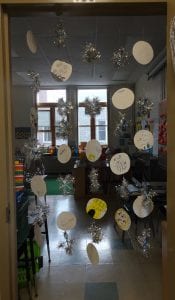 When we completed I Survived the Children’s Blizzard of 1888,we celebrated that accomplishment by having each child illustrate a snowball with their favorite scene and create a snowflake to be part of our
When we completed I Survived the Children’s Blizzard of 1888,we celebrated that accomplishment by having each child illustrate a snowball with their favorite scene and create a snowflake to be part of our 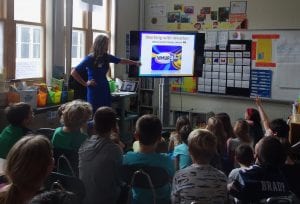 And of course,
And of course, 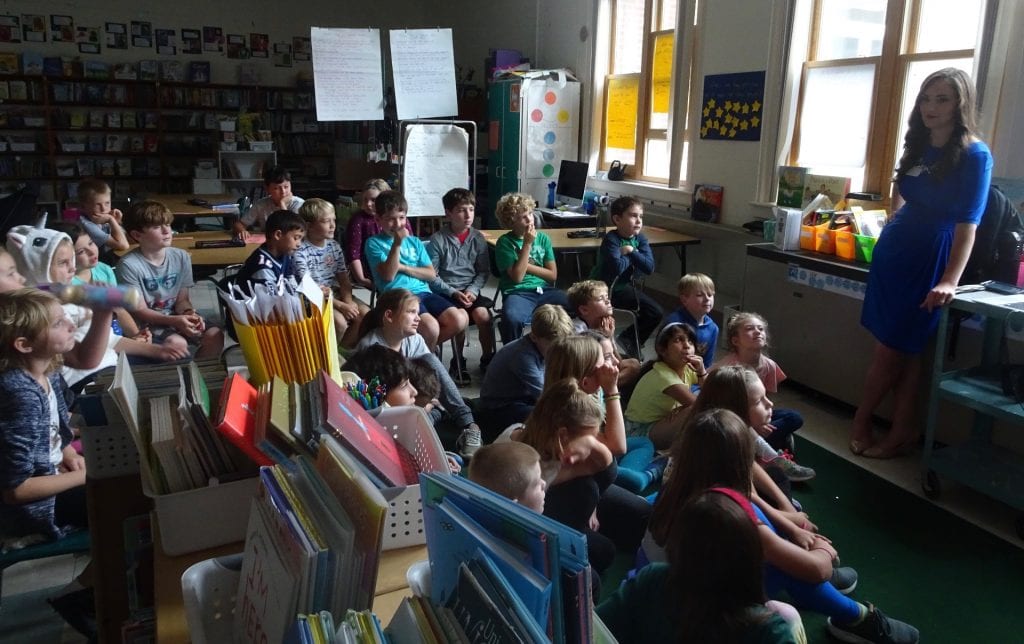

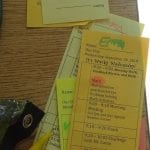 We are continuing to grow as a classroom of learners, thinker and doers. This week we began to collect reflections on learning, we read more about different types of weather and created a wind experiment. We’ve continued to learn more about multiplication and problem solving. And of course, we read and write some every day as well. This week the class discovered the Who Will Win basket. Many in the class have been passing these books around and talking about their surprise at which animal can defeat the other and how. Some of the children are trying that style or writing out on their own. It’s fun to see how interest grows and spreads across the classroom from reader to reader.
We are continuing to grow as a classroom of learners, thinker and doers. This week we began to collect reflections on learning, we read more about different types of weather and created a wind experiment. We’ve continued to learn more about multiplication and problem solving. And of course, we read and write some every day as well. This week the class discovered the Who Will Win basket. Many in the class have been passing these books around and talking about their surprise at which animal can defeat the other and how. Some of the children are trying that style or writing out on their own. It’s fun to see how interest grows and spreads across the classroom from reader to reader.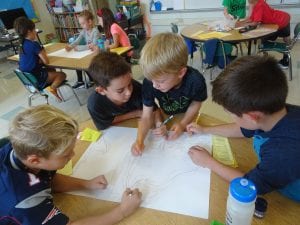 We’ve continued to learn more about the theory of multiple intelligences. This week we’ve completed a couple different questionnaires so the children would know more about themselves as learners. We used the different survey questions to think about how our interests and activities mirror the ways we are smart. It can be surprising to notice how even and balanced we are. I think the children are surprised at the balance they are noticing as well.
We’ve continued to learn more about the theory of multiple intelligences. This week we’ve completed a couple different questionnaires so the children would know more about themselves as learners. We used the different survey questions to think about how our interests and activities mirror the ways we are smart. It can be surprising to notice how even and balanced we are. I think the children are surprised at the balance they are noticing as well.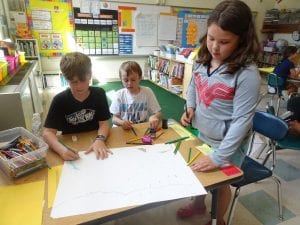 We’ve begun learning more about multiplication. We’ve learned a bit about arrays and function or ratio tables. We’ve learned that the first factor in a multiplication equation stands for the number of groups and that the second factor stands for the amount in each group. We know that multiplication is a way to add more quickly.
We’ve begun learning more about multiplication. We’ve learned a bit about arrays and function or ratio tables. We’ve learned that the first factor in a multiplication equation stands for the number of groups and that the second factor stands for the amount in each group. We know that multiplication is a way to add more quickly.
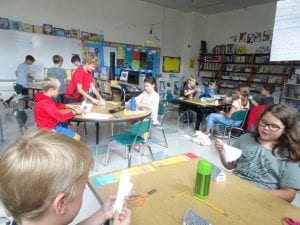 This week we worked on a design challenge. The children built a house and a wind maker (a.k.a. – fan) and then had to figure out how to change their design so the roof and house could withstand a storm. It was a lesson in dealing with frustration and difficulty for some. It was challenging when some ideas worked, while others did not. It was challenging to see those missteps as something to learn from too. We know some of what to try again another time and what not to try as well.
This week we worked on a design challenge. The children built a house and a wind maker (a.k.a. – fan) and then had to figure out how to change their design so the roof and house could withstand a storm. It was a lesson in dealing with frustration and difficulty for some. It was challenging when some ideas worked, while others did not. It was challenging to see those missteps as something to learn from too. We know some of what to try again another time and what not to try as well.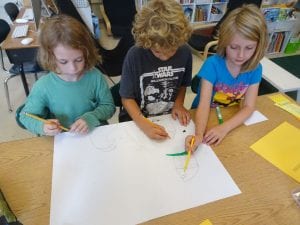 We’ll be blogging next week. We’re excited about this.
We’ll be blogging next week. We’re excited about this.
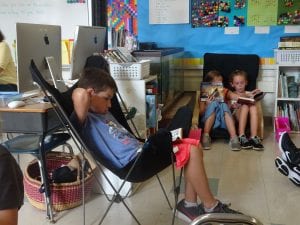


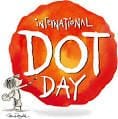 Happy Dot Day!
Happy Dot Day!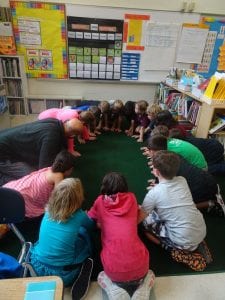 We’ve been reading a variety of biographies to see if we can discover the habits these famous people have that have leading them to success. We’ve read about scientists, Carl Sagan and Albert Einstein, athlete, Michael Jordan, artist, Henri Rousseau and farmer, Snowflake Bentley. We discovered that no matter what their passions, they all had certain habits that helped them succeed. Here’s our list.
We’ve been reading a variety of biographies to see if we can discover the habits these famous people have that have leading them to success. We’ve read about scientists, Carl Sagan and Albert Einstein, athlete, Michael Jordan, artist, Henri Rousseau and farmer, Snowflake Bentley. We discovered that no matter what their passions, they all had certain habits that helped them succeed. Here’s our list.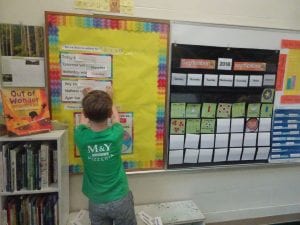 We’ve continued with our study of weather. We’ve learned more about the water cycle and terms like evaporation, condensation, transpiration and precipitation. We spent time exploring the details of storm clouds. We learned how we could make weather predictions based on the clouds we see in the sky and knowing the direction the wind is blowing. It’s pretty complicated, but also fun.
We’ve continued with our study of weather. We’ve learned more about the water cycle and terms like evaporation, condensation, transpiration and precipitation. We spent time exploring the details of storm clouds. We learned how we could make weather predictions based on the clouds we see in the sky and knowing the direction the wind is blowing. It’s pretty complicated, but also fun.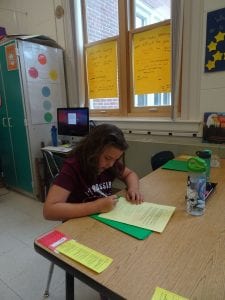
 We’ve begun learning about multiplication. We learned how to play
We’ve begun learning about multiplication. We learned how to play 
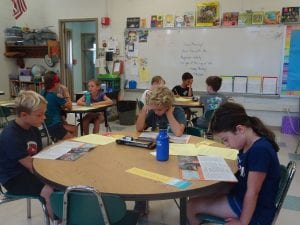 We’ve made it through another melting week. Your children have been awesome. Each day we learn a little bit more about each other and find ways to establish a classroom community that will allow us to do our best alone and succeed together. Here’s hoping this is the last of the hot and humid weather. But if not, I’m looking on the bright side – it is far better to be hot and looking forward to the school year, than being hot and wishing for summer vacation. Despite the heat, we are having a great time sharing books, writing stories, poems and reading responses, solving problems and exploring science. It is really nice to be together.
We’ve made it through another melting week. Your children have been awesome. Each day we learn a little bit more about each other and find ways to establish a classroom community that will allow us to do our best alone and succeed together. Here’s hoping this is the last of the hot and humid weather. But if not, I’m looking on the bright side – it is far better to be hot and looking forward to the school year, than being hot and wishing for summer vacation. Despite the heat, we are having a great time sharing books, writing stories, poems and reading responses, solving problems and exploring science. It is really nice to be together.
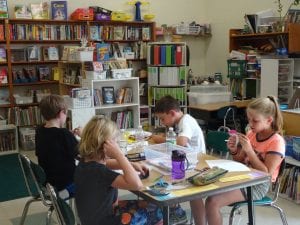 This week we learned more about different cloud types. We created our own mini-clouds to discover what exactly clouds are made of. Ask your child what they did to make it. See if they can tell you how clouds feel – are they fluffy, sticky, soft or misty? Ask your child about the lab and see what they can remember to tell you.
This week we learned more about different cloud types. We created our own mini-clouds to discover what exactly clouds are made of. Ask your child what they did to make it. See if they can tell you how clouds feel – are they fluffy, sticky, soft or misty? Ask your child about the lab and see what they can remember to tell you.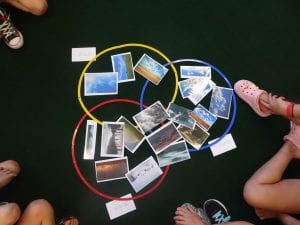 are also learning about the Water Cycle. We are learning lots of vocabulary like evaporation, water vapor, droplets, condensation and precipitation. At this point we’re not always certain yet which term is which, but we’ll get there.
are also learning about the Water Cycle. We are learning lots of vocabulary like evaporation, water vapor, droplets, condensation and precipitation. At this point we’re not always certain yet which term is which, but we’ll get there. We also began a Mind Map of interests, passions, favorites and/or hobbies. The children placed themselves in the middle of the maps and drew out connections and sub-connections. We’ll be using these next week to learn about paragraphing and to learn about the blogging process. Our first blog post will be on paper. First we’ll do the writing. Next we’ll create and search for the images that will illustrate the important parts of the writing and finally we’ll “post” it for comments. Before we comment on each other’s writing, the class will learn how to write comments that are positive, specific and helpful. We’ll invite classmates and other familiar adults in the school to make comments on post-its to attach to the paper blogs.
We also began a Mind Map of interests, passions, favorites and/or hobbies. The children placed themselves in the middle of the maps and drew out connections and sub-connections. We’ll be using these next week to learn about paragraphing and to learn about the blogging process. Our first blog post will be on paper. First we’ll do the writing. Next we’ll create and search for the images that will illustrate the important parts of the writing and finally we’ll “post” it for comments. Before we comment on each other’s writing, the class will learn how to write comments that are positive, specific and helpful. We’ll invite classmates and other familiar adults in the school to make comments on post-its to attach to the paper blogs.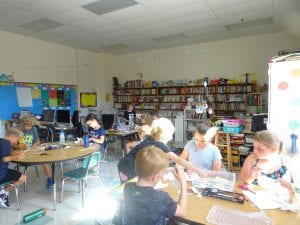 Once we are familiar with the blogging sequence – message to share, images to illustrate the message – post and (hopefully) comment – the student blogs will be set so each child can begin sharing posts for you and the world to read.
Once we are familiar with the blogging sequence – message to share, images to illustrate the message – post and (hopefully) comment – the student blogs will be set so each child can begin sharing posts for you and the world to read.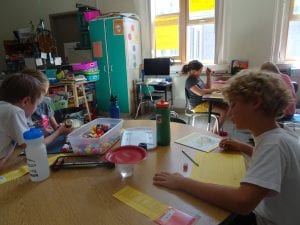 We have begun our second chapter read aloud, Phineas L. MacGuire…Erupts! This book is also part of a series that explores science and the scientific process. This series is realistic fiction.
We have begun our second chapter read aloud, Phineas L. MacGuire…Erupts! This book is also part of a series that explores science and the scientific process. This series is realistic fiction.